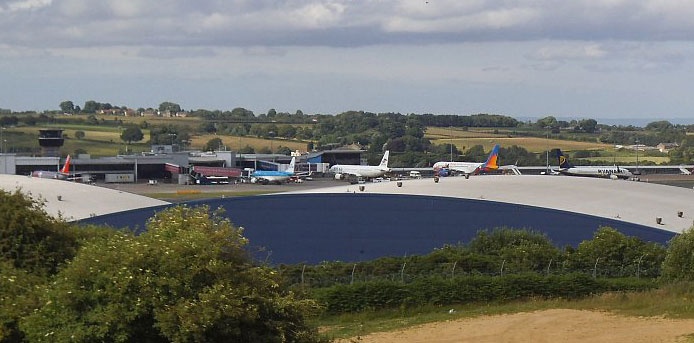The Challenge
Leeds Bradford Airport engaged AiQ Consulting to conduct a whole terminal capacity analysis incorporating a simulation study to facilitate growing passenger and baggage traffic demand. We were required to utilise the existing terminal floorplate and provide accurate flow simulations of peak day traffic, enabling the airport to strategically plan for construction mitigation’s.
This study looked at operational contingency in addition to providing guidance in optimal implementation of new technologies like CUTE, CUSS and Self-Service Bag Drops and their impact on current operations, to identify improvement opportunities throughout the passenger and bag journey, and make necessary recommendations to improve operational efficiency.
The Solution
AiQ undertook a kerb-to-gate passenger flow and capacity assessment on various scenarios to validate the planned terminal expansion over multiple phases. The operational flexibility of the airport with arriving and departing passengers crossing over at different points made the passenger simulation even more challenging. The study looked into the actual driving factors for capacity requirements specifically for Leeds by employing our extensive operational knowledge and process optimisation expertise of the AiQ team.
AiQ’s bespoke simulation tool TransvisionAiR™ was used to develop models and analyse key processes for the predicted passenger and baggage demand at kerbside, departure hall, check-in, boarding pass control, security, retail and gates. The study included validating process times, surveying passenger routing and calibrating the model against actual traffic flow data procured. The analysis detailed the waiting times and maximum queue numbers at peak time, benchmarking this against the IATA Level of Service standards.
Our holistic approach looked into combining a top-down and bottom-up approach where results from the finite capacity analysis in TransvisionAiR™ were compared to the infinite capacity planning methodology as outlined in IATA.
By implementing the 2-step process with self-service bag drop for charter low cost and full-service carriers, passenger processing efficiency was increased by 10-15% when unassisted and over 20% with assistance. However, quickly processed passengers would cause congestion at the boarding pass control, increasing risk of reduced throughput to security at busy hours. The recommendation of increasing processor capacity at boarding pass control by 65% eased out the bottleneck, helping to quickly transfer passengers to central search.
The knock-on effect at security was prevented by utilising body scanners at primary walk-through in order to avail more lanes in peak times. This increased efficiency by 30%, keeping queues and waiting times at optimum levels as described by IATA. An optimised stand allocation helped achieve better capacity at peak times considering the multiple stands serviced by limited gates.
The Benefit
Having known the constraints of the terminal floorplate, including the limited departure hall capacity, we worked with stakeholders to incorporate their views on the phased development of the airport without compromising live operations.
By being sympathetic to the airport’s needs, our holistic view and operational experience delivered real value to the client. Our recommendations enabled Leeds Bradford to increase capacity significantly and optimise their current operations. The airport was able to provide an enhanced passenger experience by improving overall passenger flows and maximise resource utilization, at the same time deferring unnecessary investment costs. We were also able to ensure that passengers dwell time in retail shopping was maximized, as 70% of retail shopping is in the departure lounge, increasing non-aeronautical revenue generation for the airport.
As the trusted airport consultancy, our unique multi skilled team of airport planners, architects, senior management consultants and physicists worked in partnership with our client to successfully integrate solutions efficiently across the airport. Utilising our extensive skills, vast operational knowledge and bespoke simulation tool, we made a real difference to overall airport operations, helping protect its future whilst maximising competitive advantage.
- Our holistic view delivered real value to the overall airport operations
- Kerb-to-gate passenger flow and capacity assessment on various scenarios
- Simulations to validate the planned terminal expansion over multiple phases
- Accurate simulations of key processes for predicted demand
- Recommendation of new technologies
- Increased capacity utilising existing terminal footplate
- Effective stakeholder management
- 20% increased efficiency in passenger processing when assisted with 2-step process with self-service bag drop
- 10-15% increased efficiency in passenger processing when unassisted with 2-step process with self-service bag drop
- Recommendation of increasing processor capacity at boarding pass control by 65% eased the bottleneck
- Provided an enhanced passenger experience
- Maximised resource utilisation
- Prevented unnecessary investment costs
What the client says
“ In preparation for our summer peak, we found the AiQ simulation an accurate predictor of what we experienced during our busiest period and helped ensured we had an action plan in place. The recommendations AiQ provided, enabled us to better plan and manage our peak operations through the implementation of the correct technology and process.
We have been delighted with the work AiQ have undertaken and look forward to engaging with them to look at future capacity planning over the coming months. ”
Operations Director, Leeds Bradford Airport


